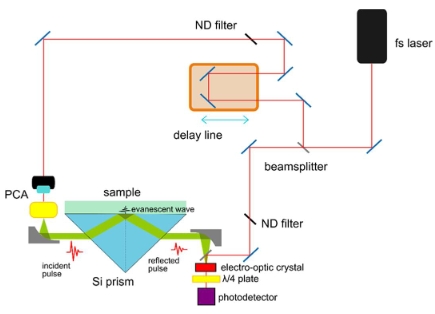High-sensitivity pesticide detection on mango skin via terahertz spectroscopy with graphene oxide sensor
DOI:
https://doi.org/10.18686/fnc.v1i2.26Keywords:
THz spectroscopy; pesticide monitoring; plasmonic sensors; agricultural crops; attenuated total reflectanceAbstract
Regular monitoring of pesticides in agricultural farmland is essential to prevent the misuse of toxic pesticide chemicals. As crop samples are typically disintegrated to extract the pesticide residue for chromatographic analysis, non-destructive techniques for pesticide monitoring are ideal for preventing the unwanted destruction of crops. This, however, requires analytical techniques that can detect trace pesticide amounts. Here, we show that terahertz (THz) spectroscopy in attenuated total reflection mode, combined with a low-cost graphene oxide (GO) plasmonic sensor, can be used for sensitive, fast, and non-destructive pesticide detection on mango skin. After the application of a pesticide solution onto the mango skin, the dried pesticide residue was transferred to the GO sensor by pressing it in contact with the mango skin surface. Due to the adsorption of the pesticide molecules onto the oxygen-rich GO surface, a signal in the THz range was obtained corresponding to the pesticide’s chemical fingerprint. With this technique, pesticide surface concentrations of as low as 1 µg/cm2 on mango skins can be detected.

Downloads
Published
How to Cite
Issue
Section
License
Copyright (c) 2023 Xizu Wang, Reuben J. Yeo, Nan Zhang, Zhen Xiang Xing, Qiang Zhu, Karen Lin Ke

This work is licensed under a Creative Commons Attribution-NonCommercial 4.0 International License.
References
1. Aktar WM, Sengupta D, Chowdhury A. Impact of pesticides use in agriculture: Their benefits and hazards. Interdisciplinary Toxicology 2009; 2(1): 1–12. doi: 10.2478/v10102-009-0001-7
2. Kayawe B. Widespread use of DDT for malaria control worries environmentalist. Available online: https://www.un.org/africarenewal/magazine/january-2022/widespread-use-ddt-malaria-control-worries-environmentalist (accessed on 14 February 2023).
3. González-Curbelo MÁ, Varela-Martínez DA, Riaño-Herrera DA. Pesticide-residue analysis in soils by the QuEChERS method: A review. Molecules 2022; 27(13): 4323. doi: 10.3390/molecules27134323
4. Hua Y, Zhang H. Qualitative and quantitative detection of pesticides with terahertz time-domain spectroscopy. IEEE Transactions on Microwave Theory and Techniques 2010; 58(7): 2064–2070. doi: 10.1109/TMTT.2010.2050184
5. Xu W, Wang S, Li W, et al. Pesticide detection with covalent-organic-framework nanofilms at terahertz band. Biosensors and Bioelectronics 2022; 209: 114274. doi: 10.1016/j.bios.2022.114274
6. Peng Y, Shi C, Zhu Y, et al. Terahertz spectroscopy in biomedical field: A review on signal-to-noise ratio improvement. PhotoniX 2020; 1: 12. doi: 10.1186/s43074-020-00011-z
7. Komatsu K, Iwamoto T, Ito H, Saitoh H. THz gas sensing using terahertz time-domain spectroscopy with ceramic architecture. ACS Omega 2022; 7(35): 30768–30772. doi: 10.1021/acsomega.2c01635
8. Lee SH, Choe JH, Kim C, et al. Graphene assisted terahertz metamaterials for sensitive bio-sensing. Sensors and Actuators B: Chemical 2020; 310: 127841. doi: 10.1016/j.snb.2020.127841
9. Lee DK, Kim G, Kim C, et al. Ultrasensitive detection of residual pesticides using THz near-field enhancement. IEEE Transactions on Terahertz Science and Technology 2016; 6(3): 389–395. doi: 10.1109/TTHZ.2016.2538731
10. Qin G, Zou K, Li Y, et al. Pesticide residue determination in vegetables from western China applying gas chromatography with mass spectrometry. Biomedical Chromatography 2016; 30(9): 1430–1440. doi: 10.1002/bmc.3701
11. Ye Y, Zhang Y, Zhao Y, et al. Sensitivity influencing factors during pesticide residue detection research via a terahertz metasensor. Optics Express 2021; 29(10): 15255–15268. doi: 10.1364/OE.424367
12. Tyurnina AV, Tzanakis I, Morton J, et al. Ultrasonic exfoliation of graphene in water: A key parameter study. Carbon 2020; 168: 737–747. doi: 10.1016/j.carbon.2020.06.029
13. Hummers WS Jr, Offeman RE. Preparation of graphitic oxide. Journal of the American Chemical Society 1958; 80(6): 1339–1339. doi: 10.1021/ja01539a017
14. Yu H, Zhang B, Bulin C, et al. High-efficient synthesis of graphene oxide based on improved hummers method. Scientific Reports 2016; 6(1): 36143. doi: 10.1038/srep36143
15. Ju L, Geng B, Horng J, et al. Graphene plasmonics for tunable terahertz metamaterials. Nature Nanotechnology 2011; 6(10): 630–634. doi: 10.1038/nnano.2011.146
16. Ranjan P, Gaur S, Yadav H, et al. 2D materials: Increscent quantum flatland with immense potential for applications. Nano Convergence 2022; 9: 26. doi: 10.1186/s40580-022-00317-7
17. Chiu NF, Huang TY. Sensitivity and kinetic analysis of graphene oxide-based surface plasmon resonance biosensors. Sensors and Actuators B: Chemical 2014: 197: 35–42. doi: 10.1016/j.snb.2014.02.033
18. Cittadini M, Bersani M, Perrozzi F, et al. Graphene oxide coupled with gold nanoparticles for localized surface plasmon resonance based gas sensor. Carbon 2014; 69: 452–459. doi: 10.1016/j.carbon.2013.12.048
19. Wu T, Liu S, Luo Y, et al. Surface plasmon resonance-induced visible light photocatalytic reduction of graphene oxide: Using Ag nanoparticles as a plasmonic photocatalyst. Nanoscale 2011; 3(5): 2142–2144. doi: 10.1039/c1nr10128e
20. Mencarelli D, Nishina Y, Ishikawa A, et al. THz plasmonic resonances in hybrid reduced-graphene-oxide and graphene patterns for sensing applications 2017; 3(1), 89–96. doi: 10.1515/odps-2017-0011
21. Zhang X, Xiang D, Wu Y, et al. High-performance flexible strain sensors based on biaxially stretched conductive polymer composites with carbon nanotubes immobilized on reduced graphene oxide. Composites Part A: Applied Science and Manufacturing 2021; 151: 106665. doi: 10.1016/j.compositesa.2021.106665
22. Justino CIL, Gomes AR, Freitas AC, et al. Graphene based sensors and biosensors. TrAC Trends in Analytical Chemistry 2017; 91: 53–66. doi: 10.1016/j.trac.2017.04.003
23. Ananda Murthy HC, Gebremedhn Kelele K, Ravikumar CR, et al. Graphene-supported nanomaterials as electrochemical sensors: A mini review. Results in Chemistry 2021; 3: 100131. doi: 10.1016/j.rechem.2021.100131
24. Shao Y, Wang J, Wu H, et al. Graphene based electrochemical sensors and biosensors: A review. Electroanalysis 2010; 22(10): 1027–1036. doi: 10.1002/elan.200900571
25. Chi SC, Lee CL, Chang CM. Adsorption of pesticides, antibiotics and microcystin-lr by graphene and hexagonal boron nitride nano-systems: A semiempirical PM7 and theoretical HSAB study. Crystals 2022; 12(8): 1068. doi: 10.3390/cryst12081068
26. Pang S, Yang T, He L. Review of surface enhanced Raman spectroscopic (SERS) detection of synthetic chemical pesticides. TrAC Trends in Analytical Chemistry 2016; 85(Part A): 73–82. doi: 10.1016/j.trac.2016.06.017
27. Chinn C, Lund AE, Yim GKW. The central actions of lidocaine and a pesticide, chlordimeform. Neuropharmacology 1977; 16(12): 867–871. doi: 10.1016/0028-3908(77)90150-2
28. Lapied B, Grolleau F, Sattelle DB. Indoxacarb, an oxadiazine insecticide, blocks insect neuronal sodium channels. British Journal of Pharmacology 2001; 132(2): 587–595. doi: 10.1038/sj.bjp.0703853.
29. Cote LJ, Kim F, Huang J. Langmuir-blodgett assembly of graphite oxide single layers. Journal of the American Chemical Society 2009; 131(3): 1043–1049. doi: 10.1021/ja806262m
30. Cote LJ, Cruz-Silva R, Huang J. Flash reduction and patterning of graphite oxide and its polymer composite. Journal of the American Chemical Society 2009; 131(31): 11027–11032. doi: 10.1021/ja902348k
31. Kim J, Cote LJ, Kim F, et al. Graphene oxide sheets at interfaces. Journal of the American Chemical Society 2010; 132(23): 8180–8186. doi: 10.1021/ja102777p
32. Carvalho A, Costa MCF, Marangoni VS, et al. The degree of oxidation of graphene oxide. Nanomaterials 2021; 11(3): 560. doi: 10.3390/nano11030560
33. Obradovic J, Newnham DA, Taday PF. Attenuated total reflection explores the terahertz region. Available online: https://www.americanlaboratory.com/913-Technical-Articles/1457-Attenuated-Total-Reflection-Explores-the-Terahertz-Region/ (accessed on 9 February 2023).
34. Holm RT, Palik ED. Thin-film absorption coefficients by attenuated-total-reflection spectroscopy. Apploed Optics 1978; 17(3): 394–403. doi: 10.1364/AO.17.000394
35. Hirori H, Yamashita K, Nagai M, Tanaka K. Attenuated total reflection spectroscopy in time domain using terahertz coherent pulses. Japanese Journal of Applied Physics 2004; 43(10A): L1287. doi: 10.1143/JJAP.43.L1287
36. Lai WE, Zhang HW, Zhu YH, Wen QY. A novel method of terahertz spectroscopy and imaging in reflection geometry. Applied Spectroscopy 2013; 67(1): 36–39. doi: 10.1366/12-06713
37. Cruz-Silva R, Endo M, Terrones M. Graphene oxide films, fibers, and membranes. Nanotechnology Reviews 2016; 5(4): 377–391. doi: 10.1515/ntrev-2015-0041
38. Tardani F, Neri W, Zakri C, et al. Shear rheology control of wrinkles and patterns in graphene oxide films. Langmuir 2018; 34(9): 2996–3002. doi: 10.1021/acs.langmuir.7b04281
39. Gengenbach TR, Major GH, Linford MR, Easton CD. Practical guides for X-ray photoelectron spectroscopy (XPS): Interpreting the carbon 1s spectrum. Journal of Vacuum Science & Technology A 2021; 39(1): 013204. doi: 10.1116/6.0000682
40. Lee AY, Yang K, Anh ND, et al. Raman study of D* band in graphene oxide and its correlation with reduction. Applied Surface Science 2021; 536: 147990. doi: 10.1016/j.apsusc.2020.147990
41. Eckmann A, Felten A, Mishchenko A, et al. Probing the nature of defects in graphene by Raman spectroscopy. Nano Letters 2012; 12(8): 3925–3930. doi: 10.1021/nl300901a
42. López-Díaz D, López Holgado M, García-Fierro JL, Velázquez MM. Evolution of the Raman spectrum with the chemical composition of graphene oxide. The Journal of Physical Chemistry C 2017; 121(37): 20489–20497. doi: 10.1021/acs.jpcc.7b06236
43. Muzyka R, Drewniak S, Pustelny T, et al. Characterization of graphite oxide and reduced graphene oxide obtained from different graphite precursors and oxidized by different methods using Raman spectroscopy. Materials 2018; 11(7): 1050. doi: 10.3390/ma11071050
44. Claramunt S, Varea A, López-Díaz D, et al. The importance of interbands on the interpretation of the Raman spectrum of graphene oxide. The Journal of Physical Chemistry C 2015; 119(18): 10123–10129. doi: 10.1021/acs.jpcc.5b01590




.jpg)
.jpg)

